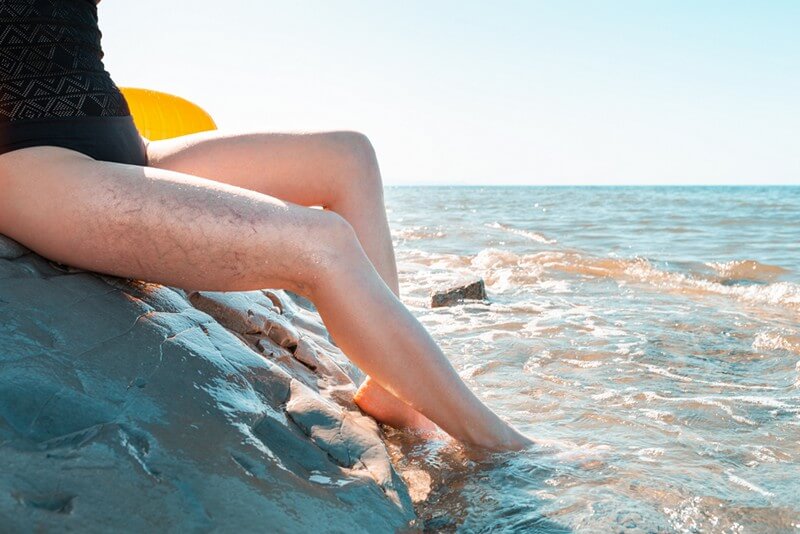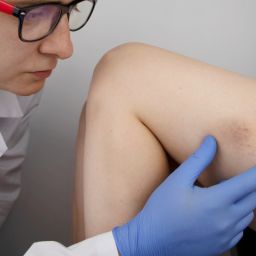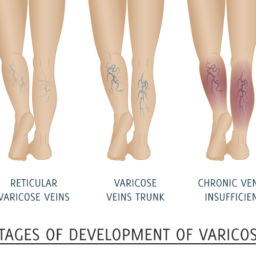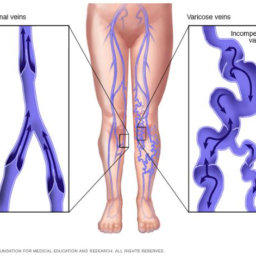
For South Florida residents, visible spider veins on legs can be a bit of a sore spot. Not only can they be uncomfortable, but varicose and spider veins can also make it more difficult to enjoy the year-round shorts weather with confidence. Furthermore, dark and twisted veins could actually be signs of a more serious problem. Th e words “varicose vein healthy feet” don’t go together for very goo reasons.
While varicose and spider veins are a result of damaged vein valves, disrupting your normal blood flow and causing it to pool, there are some differences between the two and their causes.
Fortunately, if you are noticing visible veins on your lower extremities, you don’t have to cover up your legs or go through painful, expensive treatments. Our in-house vein specialists work with our podiatrist to quickly and accurately diagnose your veins, ensure you have no underlying issues and treat the condition.
What are Varicose Veins?
Varicose veins can easily be seen through the skin. Symptoms include large, swollen, twisted and raised veins. They are usually dark blue, red or skin-colored, and they deeper in the body. They mostly commonly appear on the front and back of your calves, your thighs, or near your ankles and feet on your inner legs. Most people who develop varicose veins will almost always have spider veins as well.
What are Spider Veins?
At some point in you’re life, you’re bound to get spider veins. And while spider veins and varicose veins are connected, some people who have spider veins will never have varicose veins. Spider veins are usually red, smaller than varicose veins and they affect the veins found in your skin’s outer layer. They are usually red and they are often compared to spider webs or tree branches. Spider veins do not cause your skin to bulge like varicose veins commonly do.
Varicose Veins vs. Spider Veins: What’s the Difference
Although varicose and spider veins are often mentioned together, they differ significantly in appearance, symptoms, and severity. Varicose veins are larger, bulging, and raised, often taking on a twisted, rope-like appearance. They may cause discomfort, such as aching, throbbing, or a heavy feeling in the legs. These veins are typically dark blue, red, or skin-colored and are found deeper in the body, commonly on the calves, thighs, or near the ankles.
Spider veins, on the other hand, are smaller, thinner, and less prominent. They appear closer to the skin’s surface, forming web-like or tree-branch patterns. Spider veins are usually red or purple and generally do not cause the bulging or discomfort that varicose veins can. While both conditions result from damaged vein valves, their impact and treatment needs vary.
Causes of Vein Issues
When the walls and valves of your veins are damaged and do not function properly, your blood can flow backwards and pool. This is known as venous insufficiency. The causes of this can vary, some of which can be prevented.
For some people, chronic venous insufficiency is hereditary, meaning you have no control over the development of the condition. Varicose and spider veins are also a result of spending too much time on your feet, sitting for long periods at a time, obesity or pregnancy.
When left untreated, varicose and spider veins can start to become painful.
What Are the Risk Factors for Varicose Veins?
Various factors can raise the risk of developing varicose veins. These include:
- Genetics: A family history of vein problems can predispose you to varicose veins.
- Age: The risk increases as veins lose elasticity, and valves weaken.
- Gender: Women face a higher risk of developing varicose veins due to hormonal changes that occur during pregnancy, menstruation, and menopause.
- Prolonged Standing or Sitting: Jobs requiring extended periods of standing or sitting can disrupt normal blood flow, leading to vein issues.
- Obesity: Excess body weight puts additional pressure on your veins.
- Pregnancy: Increased blood volume during pregnancy can enlarge veins, and hormonal changes may weaken vein walls.
Understanding these risk factors can help you make lifestyle adjustments to reduce your chances of developing varicose veins.
Complications and Prevention of Varicose Veins
If untreated, varicose veins can cause complications, including:
- Pain and Swelling: Persistent discomfort and swelling in the legs.
- Skin Changes: Discoloration, rashes, or thickened skin near the affected veins.
- Ulcers: Open sores, particularly around the ankles, due to prolonged blood pooling.
- Blood Clots: In severe cases, blood clots (deep vein thrombosis) can develop, requiring immediate medical attention.
Preventative Measures for Varicose Veins
- Keep a healthy weight to ease the pressure on your veins.
- Stay active with regular exercise to improve circulation.
- Avoid long periods of standing or sitting. If unavoidable, take frequent breaks to stretch or move around.
- Elevate your legs whenever possible to reduce swelling.
- Wear compression stockings to support blood flow in your legs.
Laser Treatment for Varicose Veins
One of the most effective modern treatments for varicose veins is laser therapy. This minimally invasive procedure involves using concentrated light energy to target and close off damaged veins. The heat generated by the laser seals the vein, redirecting blood flow to healthier veins and allowing the treated vein to fade over time.
Benefits of Laser Treatment:
- Quick Recovery: In most cases, patients can feel comfort and return to their daily activities.
- Minimal Discomfort: The procedure provides a comfortable experience under local anesthesia.
- High Success Rate: Laser treatment effectively eliminates varicose veins and improves leg appearance.
- No Scarring: There are no incisions, so the procedure leaves no visible scars.
Seek out a Vein Care Specialist For Spider Veins On Legs
If you have been dealing with the effects of visible spider vein on legs, you may be tempted to try at-home treatments. Just know, aside from some lifestyle adjustments, you will need to see a specialist for proper treatment to improve the appearance of spider and varicose veins. With the right, minimally invasive treatment, we can close off vein and stop the flow of blood completely.
Our in-house vein specialist, Dr. Randal Orem, is an expert in varicose and spider veins on legs.
Give us a call today to make an appointment: 1-855-550-FEET.
Frequently Asked Questions
Q: What are the early symptoms of varicose veins?
A: Early signs include visible bulging veins, leg heaviness, swelling, aching, and itching. These symptoms often worsen after prolonged standing or sitting.
Q: When should I worry about varicose veins?
A: Seek medical attention if you experience persistent pain, swelling, skin discoloration, or open sores near the affected veins. These could indicate more serious complications.
Q: Are spider veins dangerous?
A: Spider veins are usually harmless and cosmetic. However, they may signal underlying vein issues if accompanied by other symptoms.
Q: What are the risks of leaving varicose veins untreated?
A: Untreated varicose veins can lead to pain, swelling, skin ulcers, blood clots, and other complications, such as chronic venous insufficiency.
Q: What is the safest treatment for varicose veins?
A: Minimally invasive options like endovenous laser therapy (EVLT) or sclerotherapy are considered safe and effective. Consult a specialist to determine the best treatment for your condition.





